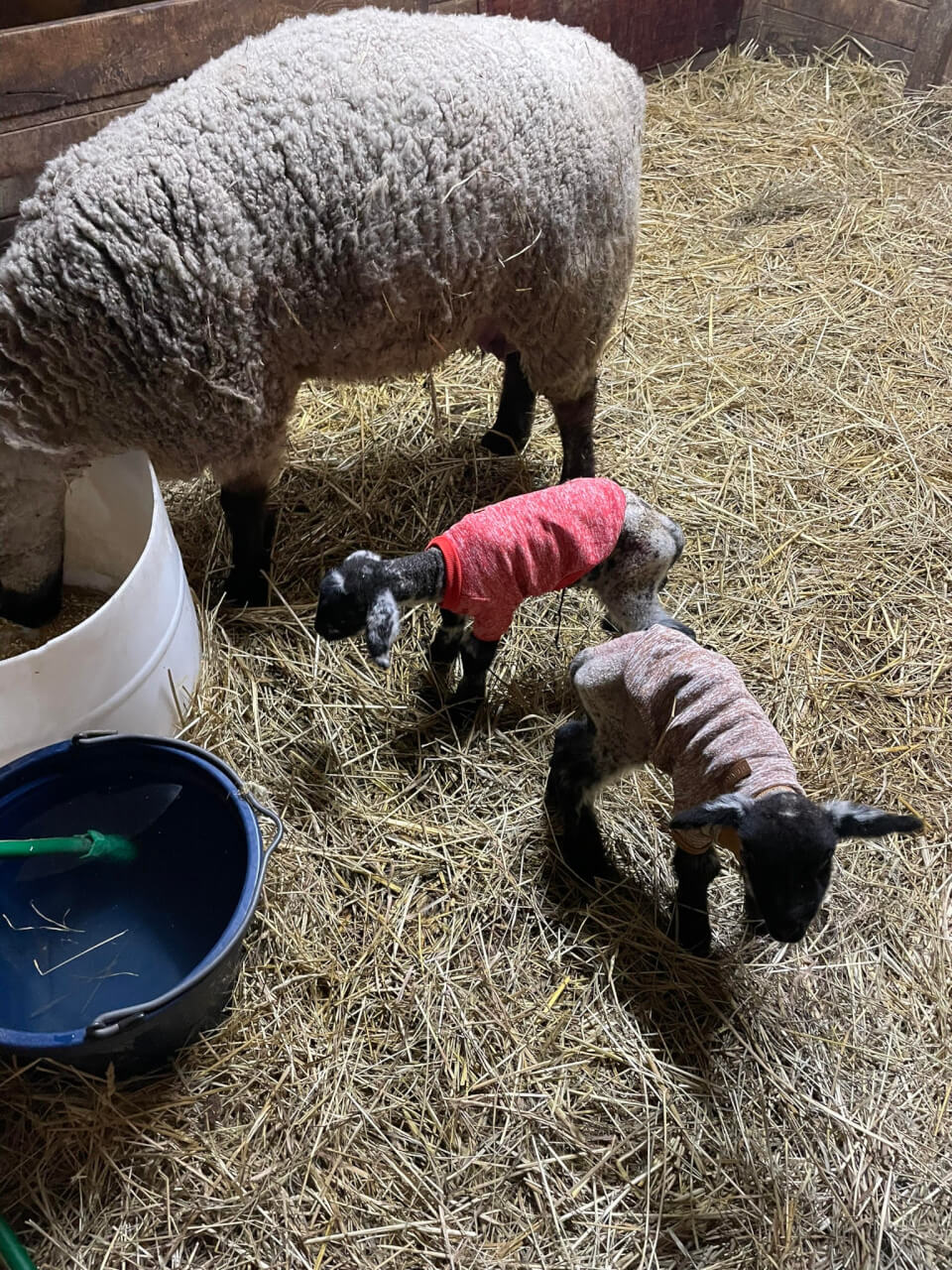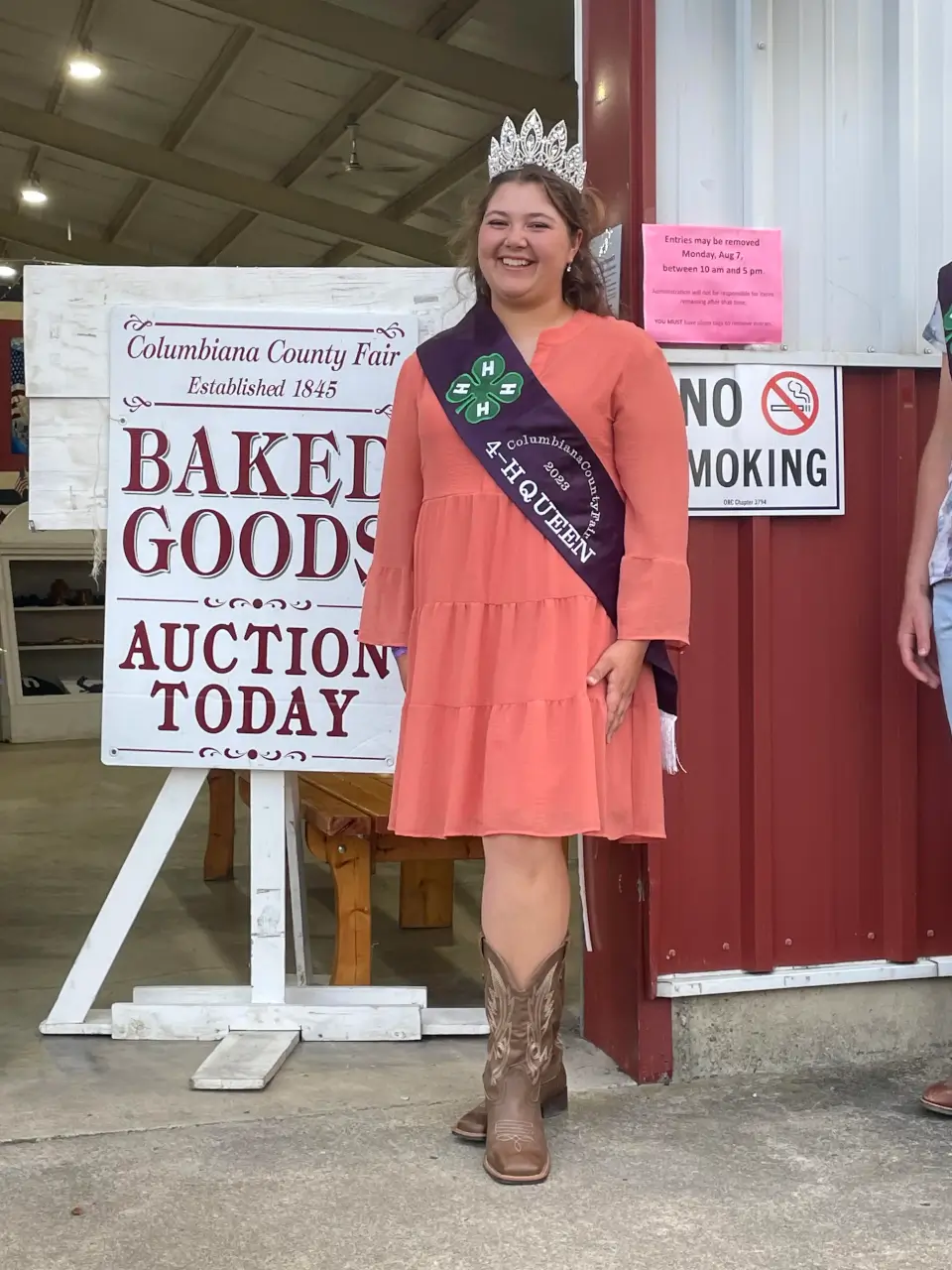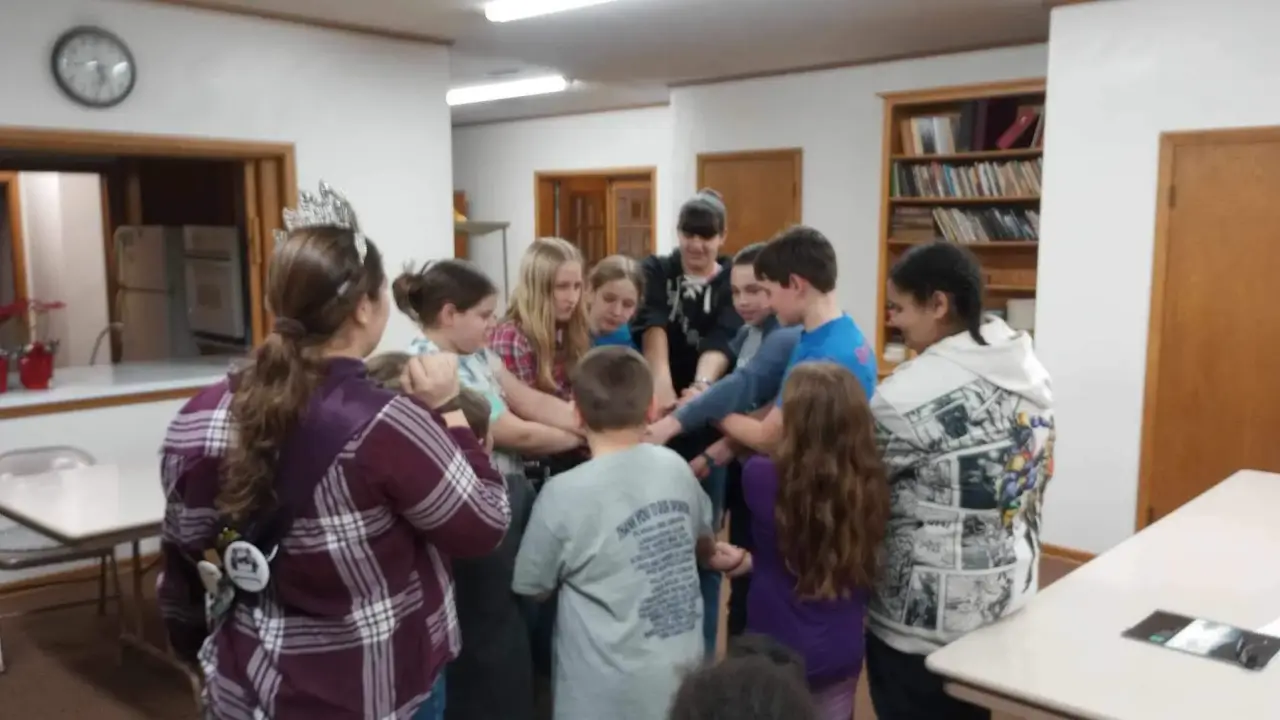Young People Need to Find Farming. 4-H is the Answer
The average age of farmers in the US is close to 60, and young farmers have trouble finding a way into the field. Programs like 4-H are the best option.
Young People Need to Find Farming. 4-H is the Answer
The average age of farmers in the US is close to 60, and young farmers have trouble finding a way into the field. Programs like 4-H are the best option.

Sara Bailey, the 4-H County Queen. via author.
This story is part of our Future Farmers series, highlighting the joys and hurdles of a career in agriculture today. You can read more of this series here.
At nine years old, I started a rabbitry. Raising my trio of Dutch rabbits to take to the fair, I fell in love with the breed and raising them. Before long, I expanded to include Polish rabbits, Dorset advantage sheep and Welsh Harlequin and Call ducks. I eventually added horses and hogs to my growing small business, raising animals for sale in my community. I named my business Diamond B Show Stock, a nod to my family farm, Diamond B farms. The family business started in the 1970s and is still running strong today. I’m proud to be the next link in the chain for my family’s agricultural business, and I hope to keep it going for the generations that come after me. And I got here with the help of 4-H.

I grew up in a farm family and, as a result, I’m entirely hooked on agriculture.
There’s something special about watching a newborn lamb’s first steps, seeing it grow and ultimately feeling the satisfaction after its sale on a humid August county fair day, knowing that I’ve given it a life full of long evening walks, gentle hands, tasty treats and security. Those moments reassure me that agriculture will always be a part of my life; now, as I work through my plethora of 4-H projects, I’m in college studying to be a veterinarian and eventually working to protect and improve the lives of livestock.
But not every kid has the opportunities I’ve had. Our industry is suffering from an inability to summon enough youth passion to join its ranks. I attended the National 4-H Conference in Washington, D.C. this April, where US Secretary of Agriculture Tom Vilsack explained it best: The average age of a farmer is close to 60 years old. To protect the future of America’s food, youth must become involved in agriculture, and organizations such as 4-H are the solution.

More than just agriculture
Established in 1912, 4-H (collectively, head, heart, hands and health) was originally conceived to introduce youth to agricultural work through after-school programs. More than 100 years later, it’s grown to encompass so much more. Each regional 4-H club hosts a variety of programs, with a focus on hands-on learning. You can raise animals, like I do, but you can also learn about all sorts of things, such as photography, public speaking, sewing or technology.
McKenzie Diamond, a recent high school grad from New York, is looking at college. A few years ago, she saw agriculture as just a hobby, not what she thought she could pursue as a career. But that changed last year.
Along with her other 4-H projects in nutrition, art and community service, she raised goats with her mother. After one of the goats needed to have her leg amputated, Diamond and her family met with vets from Cornell University to discuss their best course of action. It was this meeting where she realized that her hobby could become her career. “My mom grew up in a very agricultural family, and I think that it implanted on me at a young age that [agricultural] lifestyle and goals in life. Truthfully, I don’t think I would be who I am without ag in my life.” Now, Diamond intends to major in either agricultural education or agribusiness.
Fighting for the future
As lawmakers open their ears to youth voices, 4-H members have been put on the front lines in advocating for farming practices. Wyatt Morrow, a 4-H alumni and college freshman from Ohio, was selected for Citizenship Washington Focus, a nationwide 4-H opportunity recruiting teens to share their thoughts with legislators on Capitol Hill.
Morrow got to speak to the office of Ohio Senator J.D. Vance in 2023 on behalf of 4-H. Upon his return home and starting his first year at Wilmington College, he was trusted with a position by the college, one of only three freshmen in the group, to again travel to D.C., this time to advocate for the passage of the Farm Bill. Morrow called the lobbying “one of the most eye-opening experiences I’ve ever had. It showed me that advocating for issues you and others are passionate about can really make a difference in shaping our country.”
Through 4-H, he not only was given a life-altering opportunity to gain hands-on experience working with legislators, but he was able to use it to foster growth in the industry.

But it can be difficult to get kids involved in agriculture, especially urban kids or people who don’t grow up in farm families. “Kids are involved in so many different activities that demand their time. Oftentimes, coaches and teachers are not allowing them to have the time off from school or extracurricular activities that they need to fully engage in 4-H since it’s not a school-sponsored activity,” says Kathy Bruynis, an Ohio State University Extension 4-H educator.
Fortunately, one thing 4-H does have going for it is choices. With more than 200 projects available in the state of Ohio alone, such as livestock, gardening, robotics, nutrition, financial management, welding and more, there are topics for nearly every kid. Additionally, keeping with 4-H’s traditional creative spirit, 4-H professionals and volunteers are working hard to come up with new ways to recruit members. Jamie Stacy, an Ohio 4-H advisor and Junior Fair Board director, hosts bowling or swimming parties and always brings snacks. “Offering some type of food is usually a pretty good way to pull kids in when they get free food and fun,” says Stacy.

Becoming royalty
Fair or 4-H royalty serve as another valuable tool for recruiting new 4-H members. I was chosen as my county’s queen nearly a year ago after completing a lengthy application and interview process. On the first day of our county fair, I was presented with my crown and sash and given the job of representing 4-H not only to others in agriculture but the general public as well. After a week of helping out at shows, sales and other fair events, I was tasked with visiting other local fairs and festivals. When the fair season wrapped up, I made it a priority to involve myself in the community in other ways. I passed out candy at a Trunk-or-Treat, taking time to socialize with each child and talk to them about why 4-H really mattered to me. I read a book at my local library and eagerly answered the questions fired at me from kids and parents alike. I hugged a veteran as he accepted a quilt made by a 4-H-er at my fair’s annual quilts for veterans and first responders event, and I later connected with Wreaths for Veterans to place wreaths at a nearby cemetery at Christmas. One of my favorite experiences was taking a few baby rabbits and a baby goat with a 4-H friend to a nursing home and seeing the reactions of the residents.

All of these experiences helped 4-H project a positive image onto the local community. Prior to my visits, many of the people I met didn’t even know what 4-H was, but I left them knowing more and feeling good about it. Keeping 4-H present in the community is essential to its survival.
Follow us
This work is licensed under a Creative Commons Attribution-NoDerivatives 4.0 International License.
Want to republish a Modern Farmer story?
We are happy for Modern Farmer stories to be shared, and encourage you to republish our articles for your audience. When doing so, we ask that you follow these guidelines:
Please credit us and our writers
For the author byline, please use “Author Name, Modern Farmer.” At the top of our stories, if on the web, please include this text and link: “This story was originally published by Modern Farmer.”
Please make sure to include a link back to either our home page or the article URL.
At the bottom of the story, please include the following text:
“Modern Farmer is a nonprofit initiative dedicated to raising awareness and catalyzing action at the intersection of food, agriculture, and society. Read more at <link>Modern Farmer</link>.”
Use our widget
We’d like to be able to track our stories, so we ask that if you republish our content, you do so using our widget (located on the left hand side of the article). The HTML code has a built-in tracker that tells us the data and domain where the story was published, as well as view counts.
Check the image requirements
It’s your responsibility to confirm you're licensed to republish images in our articles. Some images, such as those from commercial providers, don't allow their images to be republished without permission or payment. Copyright terms are generally listed in the image caption and attribution. You are welcome to omit our images or substitute with your own. Charts and interactive graphics follow the same rules.
Don’t change too much. Or, ask us first.
Articles must be republished in their entirety. It’s okay to change references to time (“today” to “yesterday”) or location (“Iowa City, IA” to “here”). But please keep everything else the same.
If you feel strongly that a more material edit needs to be made, get in touch with us at [email protected]. We’re happy to discuss it with the original author, but we must have prior approval for changes before publication.
Special cases
Extracts. You may run the first few lines or paragraphs of the article and then say: “Read the full article at Modern Farmer” with a link back to the original article.
Quotes. You may quote authors provided you include a link back to the article URL.
Translations. These require writer approval. To inquire about translation of a Modern Farmer article, contact us at [email protected]
Signed consent / copyright release forms. These are not required, provided you are following these guidelines.
Print. Articles can be republished in print under these same rules, with the exception that you do not need to include the links.
Tag us
When sharing the story on social media, please tag us using the following: - Twitter (@ModFarm) - Facebook (@ModernFarmerMedia) - Instagram (@modfarm)
Use our content respectfully
Modern Farmer is a nonprofit and as such we share our content for free and in good faith in order to reach new audiences. Respectfully,
No selling ads against our stories. It’s okay to put our stories on pages with ads.
Don’t republish our material wholesale, or automatically; you need to select stories to be republished individually.
You have no rights to sell, license, syndicate, or otherwise represent yourself as the authorized owner of our material to any third parties. This means that you cannot actively publish or submit our work for syndication to third party platforms or apps like Apple News or Google News. We understand that publishers cannot fully control when certain third parties automatically summarize or crawl content from publishers’ own sites.
Keep in touch
We want to hear from you if you love Modern Farmer content, have a collaboration idea, or anything else to share. As a nonprofit outlet, we work in service of our community and are always open to comments, feedback, and ideas. Contact us at [email protected].by Sara Bailey, Modern Farmer
June 28, 2024
Modern Farmer Weekly
Solutions Hub
Innovations, ideas and inspiration. Actionable solutions for a resilient food system.
ExploreExplore other topics
Share With Us
We want to hear from Modern Farmer readers who have thoughtful commentary, actionable solutions, or helpful ideas to share.
SubmitNecessary cookies are absolutely essential for the website to function properly. This category only includes cookies that ensures basic functionalities and security features of the website. These cookies do not store any personal information.
Any cookies that may not be particularly necessary for the website to function and are used specifically to collect user personal data via analytics, ads, other embedded contents are termed as non-necessary cookies.
Excellent success story. 4H is the brand US and lessons learned should be up scaled and out scaled to motivate and attract youth in agriculture.